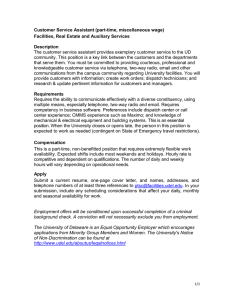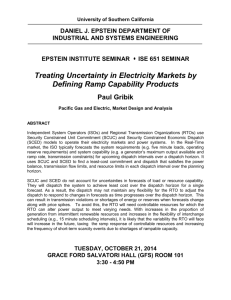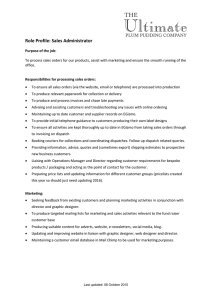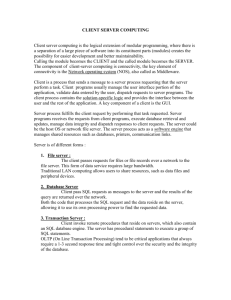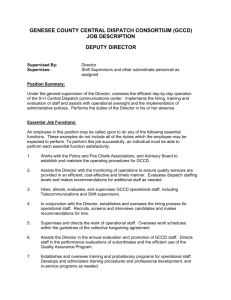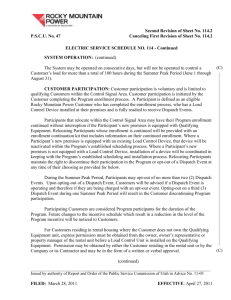Management Efficiency Assessment of the Interagency Wildland Fire
advertisement
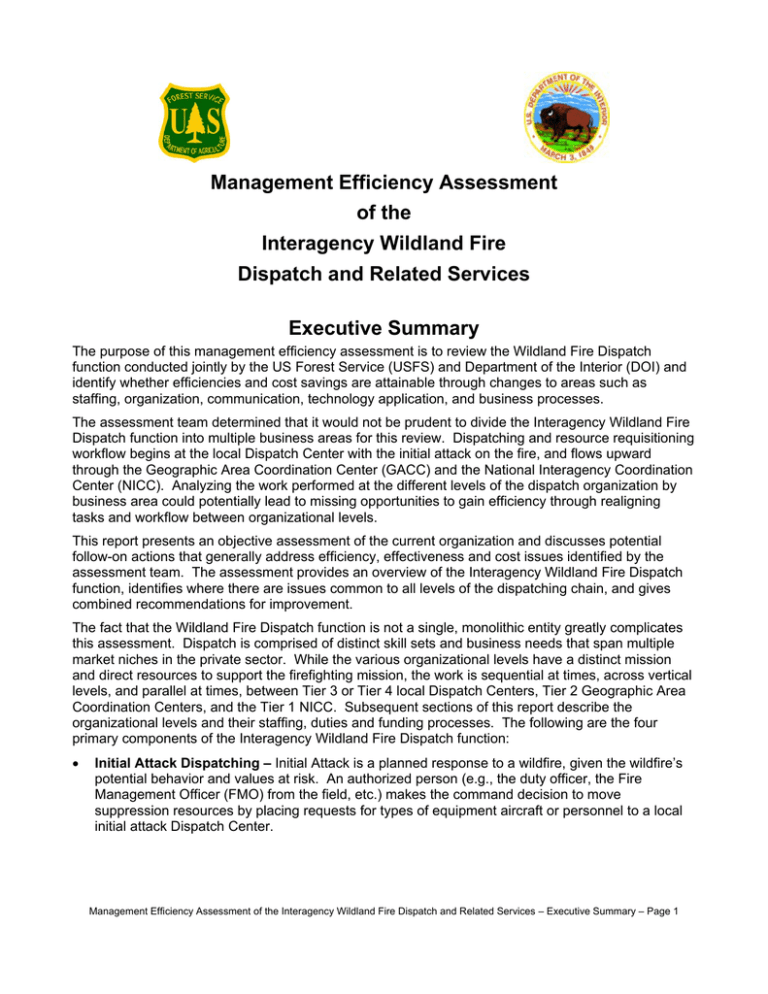
Management Efficiency Assessment of the Interagency Wildland Fire Dispatch and Related Services Executive Summary The purpose of this management efficiency assessment is to review the Wildland Fire Dispatch function conducted jointly by the US Forest Service (USFS) and Department of the Interior (DOI) and identify whether efficiencies and cost savings are attainable through changes to areas such as staffing, organization, communication, technology application, and business processes. The assessment team determined that it would not be prudent to divide the Interagency Wildland Fire Dispatch function into multiple business areas for this review. Dispatching and resource requisitioning workflow begins at the local Dispatch Center with the initial attack on the fire, and flows upward through the Geographic Area Coordination Center (GACC) and the National Interagency Coordination Center (NICC). Analyzing the work performed at the different levels of the dispatch organization by business area could potentially lead to missing opportunities to gain efficiency through realigning tasks and workflow between organizational levels. This report presents an objective assessment of the current organization and discusses potential follow-on actions that generally address efficiency, effectiveness and cost issues identified by the assessment team. The assessment provides an overview of the Interagency Wildland Fire Dispatch function, identifies where there are issues common to all levels of the dispatching chain, and gives combined recommendations for improvement. The fact that the Wildland Fire Dispatch function is not a single, monolithic entity greatly complicates this assessment. Dispatch is comprised of distinct skill sets and business needs that span multiple market niches in the private sector. While the various organizational levels have a distinct mission and direct resources to support the firefighting mission, the work is sequential at times, across vertical levels, and parallel at times, between Tier 3 or Tier 4 local Dispatch Centers, Tier 2 Geographic Area Coordination Centers, and the Tier 1 NICC. Subsequent sections of this report describe the organizational levels and their staffing, duties and funding processes. The following are the four primary components of the Interagency Wildland Fire Dispatch function: • Initial Attack Dispatching – Initial Attack is a planned response to a wildfire, given the wildfire’s potential behavior and values at risk. An authorized person (e.g., the duty officer, the Fire Management Officer (FMO) from the field, etc.) makes the command decision to move suppression resources by placing requests for types of equipment aircraft or personnel to a local initial attack Dispatch Center. Management Efficiency Assessment of the Interagency Wildland Fire Dispatch and Related Services – Executive Summary – Page 1 • Resource Coordination – Resource coordination is the facilitative process of planning and communication to mobilize resources in an efficient and cost effective manner. The agency’s fire management objectives, values at risk, and appropriate management response to wildland fires dictate the implementation of this process. Resource coordination occurs at multiple levels of the dispatch and fire management function: local, geographic, national. • Expanded Dispatch Services for Large Incidents – Expanded dispatch is a temporary organization established when a high volume of activity requires increased dispatch and coordination capability. • Predictive Services / Intelligence Gathering – The Predictive Services activity supports the wildland fire community and others with information and decision support products. Wildland fire management emphasizes safety, cost containment, efficiency, and ecosystem health through the proactive use of Predictive Services decision support products. This Interagency Management Efficiency Assessment analyzes the resource coordination responsibilities at the national level (Tier 1) and the 11 GACC level (Tier 2) as separate from the dispatch responsibilities at the local level (Tier 3) and some sub-local level dispatch centers (Tier 4). Cost data for this assessment is from FY 2006 or, where possible, FY 2007 costs for the Wildland Fire Dispatch function. This assessment focuses on the Wildland Fire Agencies’ ability to bring together personnel, expertise, organizational and communications infrastructure in locations across the country to support the Wildland Fire organization and evaluates the policy and procedural direction necessary to support the dispatching processes and Agency missions and policy. Personnel may be federal, state, seasonal, contract, or Administratively Determined (AD). The review team defined a dispatching program that fulfills the wide ranging missions of the Agencies involved, as well as specific local and geographical area needs and priorities. The team identified, analyzed and evaluated many facets of the Wildland Fire Dispatch function. The final report reflects only those recommendations which the team believes are supported and proven by an objective analytical process. A number of factors the assessment and influenced the recommendations and report. These factors included fire season severity, funds availability, the impact of transferring funds from other programs to pay for suppression efforts, the capability of dispatchers to support the mission, personnel availability and safety. The assessment identifies numerous assumptions for the components of the Wildland Fire Dispatch function collectively and individually, as appropriate. The following assumptions are part of the foundation for the recommendations: • • • • • • Each geographic area varies in vegetation/fuels, topography, weather, and climatology and fire potential conditions. Various types of disasters require unique responses. Agencies will continue to dispatch resources for wildland fire suppression. Dispatch must maintain interoperability across geographical areas. Standardization of dispatch personnel, equipment and operating procedures will be necessary to meet requirements. Dispatch and telecommunications technology is dynamic and continually evolving. Management Efficiency Assessment of the Interagency Wildland Fire Dispatch and Related Services – Executive Summary – Page 2 To ensure that review recommendations are executable, the following key constraints are noted: Each wildland fire requires an appropriate management response. The dispatching of fire suppression assets requires coordinating priorities with interagency partners. Wildland fire response often meets additional funding needs by transferring funds from other agency or partner programs. The high number of dispatch personnel approaching retirement age has decreased the size of the government’s pool of qualified staff. There is an increasing requirement for the Interagency Dispatch group to respond to requests for non-fire workload, all hazard incidents, and declared emergencies. Through review of previous studies, interviews, feedback from subject matter experts and analysis of dispatch operations activity costs, this assessment identified areas for operational improvement and opportunities for the function to become more efficient and cost effective. The team recommends the Fire Executive Council further examine these areas. Management Efficiency Assessment of the Interagency Wildland Fire Dispatch and Related Services – Executive Summary – Page 3 Summary of Recommendations Interagency Wildland Fire Dispatch Services Management Efficiency Assessment Category and Description of Recommendations *Priorities are from a dispatch perspective as identified by the team, 1=first, 5=last. General Recommendations *Priority Appoint a team to evaluate and recommend changes in missions, appropriate workload levels, areas of responsibility and identify logical conceptual consolidations where appropriate. In coordination with State and Agency administrators, the findings will be reported back. The team composition should include agency Leadership, staffing subject matter experts, and external consultants. Having one or two individuals with a cohesive perspective of these studies and Exhibit 300 studies will benefit the senior leadership of all cooperating agencies. 1 FEC will request their respective fire directors to uniformly develop and implement Performance Metrics and Measures for dispatch and predictive services, and to develop both Quality Assurance Programs and Quality Control Programs. 5 Organizational Structure, Staffing and Workload *Priority Define the Dispatch / Coordination Center Workload/Staffing Mixes and implement findings and recommendations as is feasible. 1 Review the need for Forest Service Tier 4 Centers (14) and identify alternatives. 1 Tier 2 GACC’s - Review criteria, such as fire regimes and state social and political relationships, resource order workload associated with each state, the average of the current workload determined a representative value per state within each geographic area. Tier 2 and MAC Activities - Task a study team to visualize the concept center optimization of Tier 2 operations and develop a standardized decision making process. Fire-Funded On-Site IT Desktop/Database Application Support Personnel at Tier 2 and Some Tier 3 Centers - Provide Desktop / Database Support personnel at GACCs (12 months/year) and some Tier 3 centers (seasonally). Predictive Services Staffing at Optimized Concept Tier 1 and Tier 2 Coordination Centers - The National Coordinators Group will optimize Predictive Services to consolidate staffing at the optimized concept GACCs. • Analyze workload and staffing, and review the products and services being provided. Provide recommendation of the appropriate staffing level and infrastructure support, commensurate with program requirements. Consolidated (Zone) Expanded Dispatch Unit Services at Specific Tier 3 Centers - Through appropriate requisition offices, facilitate an RFP for Staffing Zone Expanded Dispatch Units with Private Sector contract personnel to augment the federal labor force during periods of resource shortages. 1 2 2 Cross-Training of Airspace Coordinators / Dispatchers at Optimized Concept Tier 2 Coordination Centers - BLM / USFS National Airspace Program Manager to Cross-train one dispatcher in each GACC to perform Airspace Coordination. 3 Centralized Coordination and Dispatch of Contract Equipment and Crews - Respective fire acquisition offices to facilitate a 5 Year Contract for a National Contract Dispatch Center with contract staff (this is a business process change and not in disagreement with FY08 appropriations). 4 Cooperative Agreements - Through appropriate requisition offices, provide additional grants and agreements personnel to support fire management at the geographic and state levels. 5 Management Efficiency Assessment of the Interagency Wildland Fire Dispatch and Related Services – Executive Summary – Page 4 Business Practices - General *Priority COOP Documentation and Backup Generators - The National Coordinators Group will oversee the completion of COOP documents for all Tier 3 Dispatch Centers. 1 Request an external agency to review backup systems capabilities for dispatch centers during national threats / disasters to make recommendations for backup power generation. 2 Business Practices – AD Management *Priority Centralized Support for AD Personnel – Review the concept of a new centralized Interagency AD Management Center to be created and attached to ASC at Albuquerque or NBC in Denver. The AD Management Center would centralize the workload currently performed at Tier 2, 3 and 4 centers associated with hiring of AD personnel (qualification and training record maintenance, payment processing, etc.). The AD Management Center’s mission would be the recruitment and screening of seasonal and/or intermittent personnel prior to and during periods of fire emergency to perform firefighting and related on site services, as described above. The mission is to include coordination with and to provide administrative support during the acquisition of incident staffing support requested through GACCs and local Dispatch Centers. 4 Interagency Consistency in Use and Hiring of AD Personnel – Respective acquisition offices to work together to provide structural and policy changes to eliminate interagency inconsistencies regarding AD personnel between DOI and the Forest Service. 5 Business Practices – Buying Teams & Procurement Improved Support to Non-Self Sufficient Crews through AQM - The Incident Business Practices Working Team to make recommendations for changes in policies on travel, lodging, subsistence, and materials/supply purchases for non-self sufficient crews to ensure that each crew is provided access to a local buying team to support its procurement requirements. 3 Improved Buying Team Support through AQM • Federal Wildland Fire Budget & Planning Team and the Incident Business Practices Working Team to assist their respective AQM offices to make changes in policies on Buying Teams to ensure that each Incident Management Team is staffed with a Buying Team liaison and provided access to a local buying team to support its procurement requirements. • AQM conduct a detailed study to ensure an adequate number of Buying Teams are available to support incident management needs. This will moderate the impact on the Dispatch Center/hosting unit employees with micro-purchase cards which quickly reach maximum limits during emergency response. Centralized Coordination and Dispatch of Contract Equipment and Crews - Task the Federal Wildland Fire Budget & Planning Team to investigate best practices and the potential effectiveness of a centralized National Contractor Dispatch Center utilizing a contract evaluation process, and report by back. 5 5 Management Efficiency Assessment of the Interagency Wildland Fire Dispatch and Related Services – Executive Summary – Page 5 Information Technology - ROSS *Priority Remaining ROSS Enhancements Completed - Respective Fire Budget coordinators task the Federal Wildland Fire Budget & Planning Team to review the business funding process and recommend allocation of adequate funding for the ROSS Schedule of Changes, Updates, & Upgrades. 1 The National Coordinators Group will develop & reorganize the ROSS List and Schedules of Changes/ Updates/ Upgrades to advance Dispatch-Championed Items to the front of the list. 1 Respective fire acquisition offices to facilitate an Exhibit 300 for ROSS-type System and Develop the RFP for its Development or a COTS purchase. 5 Next Generation of a Resource Ordering and Statusing Application - Develop the next generation resource ordering and status system. 5 Web-Based AD Personal Data Update Portal - Request modification of ROSS to implement a webbased AD personnel data interface to facilitate updating contact and availability data. 5 Information Technology – CAD *Priority Standardized CAD System Purchased/Developed for All Tier 1-3 Centers – Agency Administrators to jointly task their portfolio managers to develop a new CAD application. 1 Respective fire acquisition offices to facilitate an Exhibit 300 for CAD System and Develop the RFP for CAD Development or COTS purchase. 1 Information Technology – All Other *Priority Centralized Data Warehouse Implemented to Support New Fire Applications - Respective fire acquisition offices to facilitate an Exhibit 300 study and then Develop or Purchase a Central Data Warehouse database for all Fire Data. 1 Reengineered Wildland Fire Reporting Process – Implementation of an End-to-End Reporting Application - Agency portfolio managers to develop new End-to-End Reports (defining all data required to produce required and ad-hoc Fire reports with one-time data entry into Centralized Data Warehouse, CAD, or ROSS) and to define the needs of a unified report generator to support them. 1 Elimination of IT System Access Barriers and the Ban on Dual Networked PC’s - Respective agency (USDA / DOI) Chief Information Officers will request a waiver of system security policy to Tier 1 through 3 coordination/ dispatch center computers to access both networks. 2 Replacement of Incompatible Hardware/Software - Respective fire acquisition offices to facilitate an Exhibit 300 analysis of existing hardware (PCs/ Laptops) in Tier 1 through Tier 3 Offices (i.e., will PCs be able to operate all the new Fire applications - New ROSS, New CAD, New CDW, New End-to-End Reports Generator, etc.). The analysis will consider potential security risks. 2 Respective fire acquisition offices to facilitate a Requirements Document for a New On-line AD Database. 3 Changed Policies for Help Desk Escalation for Priority 1 and 2 Trouble Tickets in the US Forest Service Improved IT Support, Products and Equipment on an Interagency Basis Center of Expertise for Wildland Fire Dispatch IT Applications and Improvements - Initiate a five year pilot program for a 3-person IT Applications and Improvements Think Tank for the Wildland Fire Dispatch program and in support of NIMO, NICC and Training. 5 Management Efficiency Assessment of the Interagency Wildland Fire Dispatch and Related Services – Executive Summary – Page 6 Radios and Other Technology *Priority Radio Compatibility and Inventory and Analysis - Task Radio Communications Task Group with review of business processes and conduct an Inventory Analysis of all Radio Systems at Tier 3 Centers - Determine Compliance with Needs. 1 Respective fire acquisition offices to facilitate an Exhibit 300 Analysis of Replacement / Redistribution of Radios Not Compliant with New Boundary Radio Coverage Requirements. 2 GPS Tracking Units for Agency Owned Assets - Fire Equipment Working Team to be tasked with the development of a plan to purchase and to implement applying GPS Tags on items such as all federal-owned and designated Initial Attack rolling stock, vehicles and trailers, heavy equipment, generators, catering units, and shower units. 4 Improved Access and Cost Controls Through Smartcard Technology - FEC will task the Fire Equipment Working Team plan to purchase and to implement a National Wildland Fire Support SMARTCARD system for ADs, Contractors, non-federal employees, etc. who work on fires or at Dispatch/Coordination Centers, and to develop a plan to add Incident Qualifications information to a SmartCard or to the SmartChip on federal Employee Identification Cards now being issued. 5 Governance *Priority Review geographic inconsistencies in Governance policies and make recommendations to FEC. 2 Interagency Consistency in the Mobilization of Incident Management Teams - Review national and geographic inconsistencies in Governance policies and make recommendations to FEC for the standardization of Mobilization of IMTs. 5 Management Efficiency Assessment of the Interagency Wildland Fire Dispatch and Related Services – Executive Summary – Page 7
